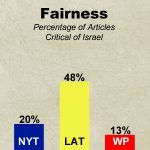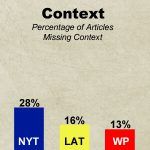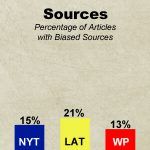At the end of March, we analyzed every single article about Israel published on the websites of the New York Times, the Washington Post, and the Los Angeles Times. We were looking for subtle yet consistent evidence of anti-Israel bias. We wanted to know if articles which contained inaccuracies about Israel were exceptions to those news organizations’ otherwise objective journalistic standards, or whether they represented an anti-Israel editorial policy reflected in the selection of coverage and writing style.
Specifically, we looked at whether the story selection was balanced between stories that reflected negatively against Israel and others that were more positive and less critical. Within the stories themselves, we looked at whether important context had been left out, resulting in stories that confuse rather than clarify the issues. We also examined the use of terminology and sources to see whether they reflected an anti-Israel bias.
Our conclusion last month, which came as no surprise to our readers, was that the New York Times was far more problematic in its coverage of Israel than the other papers. But that was only based on two months’ worth of articles. Now we can look back at four months’ worth of data. So what did we find?
- There was far less total anti-Israel bias in the media during March and April as there was during the first two months of the year. Media bias against Israel is not a constant. It changes depending on events in the Middle East. It tends to be especially bad when there are numerous clashes between Israel and the Palestinians. That is when a journalist with an agenda feels the motivation to depict Israel unfavorably. However, when the news is relatively quiet, the bias tends to be less. So it was no surprise to us that the problems — although they still exist — were far fewer during these last two months.
- With less total coverage, the differences between the news organizations in the study were far less. Yes, the New York Times tends to report and editorialize based on a perspective more critical of Israel and Israeli polices than the other papers. But the difference during this time period was not great.
Fairness
 We counted how many articles in each of the papers could be characterized as being critical of Israel or Israeli actions. Here, we are not judging the accuracy of a story. We would expect some stories to be critical of Israel over a time period, just as we would expect stories to be positive or critical of the Palestinian Authority. Just as was the case in the first two months of the year, the Washington Post was again the best in this category, with just 13 percent of articles reflecting negatively on Israel. This is actually an improvement since we found 20 percent of Post articles critical of Israel in the beginning of the year. Unfortunately, while the Post’s own reporters are doing a good job, the paper runs almost daily stories from the Associated Press. These are consistently critical and negative when it comes to Israel and thus many of the Post’s readers will have a biased view of Israel and the conflict, despite the work of the Post’s reporters.
We counted how many articles in each of the papers could be characterized as being critical of Israel or Israeli actions. Here, we are not judging the accuracy of a story. We would expect some stories to be critical of Israel over a time period, just as we would expect stories to be positive or critical of the Palestinian Authority. Just as was the case in the first two months of the year, the Washington Post was again the best in this category, with just 13 percent of articles reflecting negatively on Israel. This is actually an improvement since we found 20 percent of Post articles critical of Israel in the beginning of the year. Unfortunately, while the Post’s own reporters are doing a good job, the paper runs almost daily stories from the Associated Press. These are consistently critical and negative when it comes to Israel and thus many of the Post’s readers will have a biased view of Israel and the conflict, despite the work of the Post’s reporters.
The LA Times, on the other hand, published slightly more articles critical of Israel, going from 33 percent in the first study to 48 percent now. For example an April 7 article places the blame for the breakdown in peace talks squarely on Israel:
The talks, which were supposed to produce a peace agreement between Israel and the Palestinians by the end of April, hit a stumbling block last week when Israel did not release a group of Palestinians, as promised.
While there is some truth to this explanation, it is by no means the whole story. The Palestinians had already declared that they would not extend the talks. Israel felt that releasing the prisoners would not produce any substantive results. So while the article is technically correct, the way the story is written is critical only of Israel.
Refreshingly, the New York Times was nowhere near as critical in this area as it was during the first two months of the year. In that report, we documented 67 percent of articles expressing a bias against Israel. In March and April, that statistic had fallen to 20 percent. While we are heartened to see the difference, it still remains to be seen if this is evidence of a more balanced approach or simply the result of less events to report. With more time we will see whether this is an anomaly or not.
Context
 In terms of missing context, all three news organizations had improved. With fewer negotiations there were fewer references to “East Jerusalem, occupied by Israel in 1967.” With fewer clashes, there were fewer descriptions of Israeli “military attacks” on the Gaza Strip. On the other hand, all three papers were negligent in giving the full context of the proposed Palestinian “prisoner’ release. The prisoners have all been serving time for terrorist attacks and that fact should have been noted whenever the word “prisoner” was used.
In terms of missing context, all three news organizations had improved. With fewer negotiations there were fewer references to “East Jerusalem, occupied by Israel in 1967.” With fewer clashes, there were fewer descriptions of Israeli “military attacks” on the Gaza Strip. On the other hand, all three papers were negligent in giving the full context of the proposed Palestinian “prisoner’ release. The prisoners have all been serving time for terrorist attacks and that fact should have been noted whenever the word “prisoner” was used.
For example, in this article that appeared in the LA Times (in which 16 percent of the articles missed important context), the reader is greeted by the following photograph that referred to Palestinian “detainees” rather than “captured and tried terrorists.”
Likewise, this style also appears in 13 percent of the Washington Post articles. However, there were a few examples of the Post adding a simple line that put the issue of prisoners into context. For example, in an article on March 31, the Post writes:
But Netanyahu wants a promise from Abbas that the peace talks will continue before he frees the inmates, all of whom are serving long sentences after being convicted of murdering Israelis.
Including the line that we have highlighted in bold would seem easy and critical to accurate reporting. One can only wonder why it or a similar construction was not used in other articles reporting on the same issue.
The New York Times led the three papers in missing important context (28 percent of articles were missing essential contextual information,) as was the case two months ago. Besides stories on the proposed prisoner release, it also left out context when it came to reporting on the issue of settlements. Typical of the New York Times style is an article from March 20 that ran under the headline:
Why is the subject introduced through the filter of the Palestinian reaction? Why have there been no headlines in the New York Times similar to “Palestinian Refusal to Recognize Jewish State Renews Israeli Outrage?”
Terminology
 All three papers refer to Hamas terrorists as “militants.” While this occurred less during the time period in this study, that reduction in the term is a reflection of the fewer references to Hamas activity rather than an actual editorial decision to use more precise language. Likewise the use of the term “East Jerusalem” as if it there were a separate geographic entity from the united city of Jerusalem presents a problem with terminology. In the Washington Post, 17 percent of articles used problematic terminology. In the LA Times, the figure was 15 percent. The New York Times actually did better with this type of terminology at 13 percent. Interestingly, NYT Jerusalem Bureau Chief Jodi Rudoren wrote an article on how she strives to avoid using biased language. On March 18, Rudoren wrote:
All three papers refer to Hamas terrorists as “militants.” While this occurred less during the time period in this study, that reduction in the term is a reflection of the fewer references to Hamas activity rather than an actual editorial decision to use more precise language. Likewise the use of the term “East Jerusalem” as if it there were a separate geographic entity from the united city of Jerusalem presents a problem with terminology. In the Washington Post, 17 percent of articles used problematic terminology. In the LA Times, the figure was 15 percent. The New York Times actually did better with this type of terminology at 13 percent. Interestingly, NYT Jerusalem Bureau Chief Jodi Rudoren wrote an article on how she strives to avoid using biased language. On March 18, Rudoren wrote:
This is part of what I have come to call “conflict code”: words whose plain English meanings are politicized, distorted or undermined in the context of the Israeli-Palestinian struggle, which is much more a clash of narratives than a tussle over territory.
She’s right. But in avoiding words like “terrorist” in favor of “militant,” she is guilty of exactly what she says she is trying to avoid. Why not use the most accurate terms, regardless of who it will upset?
Sources
 The misuse of sources can take several different forms. Sometimes, articles will only use quotations from one side of a controversial issue. Or the voices on one side far outnumber the single quote from the other side. Another way quotations can be misused is if they come from non-credible sources. A source may have his or her own agenda and chooses words carefully to manipulate an issue. Or, as is the case in the Palestinian administered territories, a speaker may not be free to say what he or she really feels. Without the democratic protection of free speech, a speaker can often face repercussions for speaking out against authorities. It is the job of a journalist to use only quotations that will help a reader gain a fuller picture of what is happening.
The misuse of sources can take several different forms. Sometimes, articles will only use quotations from one side of a controversial issue. Or the voices on one side far outnumber the single quote from the other side. Another way quotations can be misused is if they come from non-credible sources. A source may have his or her own agenda and chooses words carefully to manipulate an issue. Or, as is the case in the Palestinian administered territories, a speaker may not be free to say what he or she really feels. Without the democratic protection of free speech, a speaker can often face repercussions for speaking out against authorities. It is the job of a journalist to use only quotations that will help a reader gain a fuller picture of what is happening.
All three papers carried misleading quotations in 14 to 19 percent of the articles. For example, on April 1, the LA Times quotes Mahmoud Abbas extensively, with no response from an Israeli figure. He gets away unchallenged with saying:
“Unfortunately, and after we have been promised nine times by the Israeli government to tell us its decision … this did not happen..”
Did the Israeli government really make a promise to Abbas nine times to release prisoners, only to renege? That’s the impression a reader would come away with.
This Washington Post article from April 19 does contain quotations from the Israeli side. But there are twice as many from the Palestinian side, and the article concludes with the former minister for Jerusalem Affairs for the Palestinian Authority saying:
“People are not coming to Jerusalem anymore. Who wants confrontations and tear gas? Easter is supposed to be a time of joy.”
With statistics showing no reduction in entry permits and no evidence of violent confrontations and tear gas, the above quotation is not credible and should never have been used.
Conclusion
Our study found less anti-Israel bias overall in the three major American newspapers during March and April of 2014. This is most likely due to a slower news cycle during the time period. The only way that we will be able to say that there is evidence of a change in media reporting on Israel is if we find consistent, objective reporting on the conflict over a sustained period of time. And to say that the situation may have improved, does not mean that there is not still a lot more room for better journalism.
You can contact the newspapers:
Ask the NY Times Public Editor, Margaret Sullivan, why the paper’s coverage is so biased against Israel when compared with other reputable news sources. E-mail her at [email protected].
To let the Washington Post hear your opinion, e-mail the Reader Representative.
To contact the LA Times, fill out this online form.



